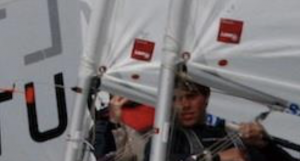Tip of the month – using the Cunningham upwind in a blow!
Andy Southall, a regular and experienced club racer at Chew, recently had his ‘cunningham epiphany’ moment at the recent Laser training day. After 10 years of Laser sailing, Andy says that he has finally realised just how much of a difference that a couple more inches of Cunningham tension can make to improving speed and enjoyment of upwind sailing in the laser in a breeze.
Let’s share the love!
When to get that Cunningham on?
If you are fully hiked but are consistently feeling weather helm on the tiller when sailing upwind; then you need to do something about it!
(Nothing subtle with this tip)
Crank that Cunningham on! No really. CRANK THAT CUNNINGHAM ON HARD!
You cannot pull it on hard enough once the wind exceeds what you can balance upwind.
Seriously, you cannot pull it on hard enough in a blow.
Since it is almost impossible to pull it on hard enough once you are hiking out upwind, if you know it is going to be windy then you need to get it on hard before rounding the leeward mark. Or, if that is too tricky then consider pulling it on hard on the shore and then leaving it on!
How much?
For new and nearly new sails then the crinkle will be almost down to the boom when you’ve finished pulling on the control line for all your worth.

Newer sail Cunningham setting – down to top of boom (courtesy of laserinternational.org)
For older sails that are more stretched, the luff crinkle for the Cunningham will need to be below (yes below!) the boom. Make sure that your setup can accommodate this (don’t be afraid to ask an experienced front-runner to check your setup ashore). We often find that sailors setups don’t allow them to get anywhere near enough Cunningham on.
Yes. It will look horrible when you pull it on as hard as it needs to go on (which is obscenely hard); then you will get sailing and realise that the massive crease at the luff has now all but disappeared and you are sailing faster and with less weather helm!
What does this do for my sailing?
If you are suffering from weather helm (feeling like you must pull on the tiller to keep the boat going in a straight line) then you will be going slowly. It will also hurt your arm after a while and you’ll spend more time getting to the windward mark. Nobody wants this!
The reason that weather helm is slow is that pulling on the tiller, particularly persistently, creates drag from the rudder. This causes slowing; it is akin to pulling a rudder sideways through the water.
Yeah, okay so I go a bit slower, but so what?
Slowing is bad because not only do you go slow (dur!); but you also tend to slip-sideways more (leeway). This is because the faster you go the more lift (to windward) you get from your underwater foils; you daggerboard and rudder.
Also, and perhaps less well known, is that when you are heeling to leeward upwind, that pulling on your tiller tends to make the boat tip further to leeward. Double trouble!
Slightly more technical bit…(stop reading if you’ve had enough…!) why does the Cunningham help reduce weather helm?
When you pull the Cunningham on you put tension into the front of the sail (luff) and reduce the tension in the back of the sail (leach). This has an overall impact of dragging the ‘centre of effort’ of the sail towards the front of the boat.
If the centre of effort of the sail is aft of the centre of effort of the hull (centre of lateral resistance – otherwise known as ‘lift’ from the hull and foils) then the boat will want to keep heading up all by itself.
If the centre of effort of the sail is forward of the centre of effort of the hull, then the boat will want to keep bearing away up all by itself. (for those at the training day; think what a windsurfer does to make his windsurf board bear away).
As the breeze increases the centre of effort of the sail automatically starts moving aft (just take this at face value – it just does).
If you are finding that the boat keeps wanting to head up when you are going upwind in a blow, then you need to bring the centre of effort of the sail further forward. This is one important thing that the Cunningham does!
Yes! There is more!
Pulling the Cunningham on hard also flattens the upper third of the sail and generates ‘twist’ (the top of the sail is effectively sheeted out compared to the bottom – there is a previous tip of the month dedicated to this).
Brilliant news for a blow! We’ve now effectively sheeted out and de-powered the top of the sail, where all the tipping moment is. This means that we can keep the boat flat with the sail sheeted in tighter much more easily than if we would have if we hadn’t pulled the Cunningham on.
This will help us with our pointing as the winds freshens.
And there is more!
The Cunningham helps you to steer around the through the chop; avoiding nasty waves.
A balanced helm (without weather helm) makes steering so much easier. This is helpful when it gets choppy, as we need to steer more to avoid smashing our bow into waves and slowing (remember, slowing is bad for lots of reasons!).
If we have weather helm, then we find ourselves pulling very hard on the tiller to make the boat bear away to avoid smashing into a wave. This will generate a lot of drag and sometimes the boat simply won’t respond; the boat will slow down and smash into the wave anyway.
Summary
If you are fully hiked but are consistently feeling weather helm on the tiller when sailing upwind; pull on your Cunningham as hard as you can.
Then, think about how much it will shorten your time spend hiking to the windward mark (probably 1-2 minutes shorter); and put everything, including your powerful leg muscles, into it. Every centimetre extra of downhaul makes a big difference!
See you on the water!
Steve Smith
Laser 209926
Chew Valley Lake Sailing Club
